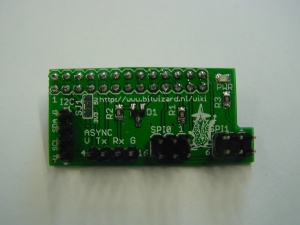Difference between revisions of "Raspberry Pi Serial"
Jump to navigation
Jump to search
| Line 4: | Line 4: | ||
The RPI_SERIAL board breaks out the serial busses on the raspberry pi. This allows the raspberry pi to communicate at 3.3V CMOS levels with say an arduino mini or other 3.3V asynchronous devices. But also the I2C bus and SPI busses are broken out. BitWizard has a bunch of expansion boards that can connect to those busses. |
The RPI_SERIAL board breaks out the serial busses on the raspberry pi. This allows the raspberry pi to communicate at 3.3V CMOS levels with say an arduino mini or other 3.3V asynchronous devices. But also the I2C bus and SPI busses are broken out. BitWizard has a bunch of expansion boards that can connect to those busses. |
||
This page will say more about the hardware in the future, once things are tested. For now see [[Raspberry pi expansion system page]] |
|||
== Overview == |
== Overview == |
||
Revision as of 15:26, 15 March 2012
This is the documentation page for the Raspberry Pi Serial board.
The RPI_SERIAL board breaks out the serial busses on the raspberry pi. This allows the raspberry pi to communicate at 3.3V CMOS levels with say an arduino mini or other 3.3V asynchronous devices. But also the I2C bus and SPI busses are broken out. BitWizard has a bunch of expansion boards that can connect to those busses.
This page will say more about the hardware in the future, once things are tested. For now see Raspberry pi expansion system page
Overview
Assembly instructions
Possible Configurations
External resources
Datasheets
Additional software
Related projects
Pinout
LEDs
Jumper settings
Programming
The software
Default operation
Future hardware enhancements
Future software enhancements
Changelog
- Initial public release
